State
Aquatic Warbler – a rare and charismatic bird, that needs our help
In the last century, 95% of all aquatic warblers have gone extinct. The global population continues to shrink. There are only 4 countries left in the world where these rare birds are able to breed and nest – Belarus, Ukraine, Poland (containing 95% of the global population) and Lithuania. Several years ago, the warblers were able to nest in Germany, Latvia, and Hungary.
According to BirdLife International, 2015, the populations are as follows:
- 9 000–13 800* singing males
- 18 000–27 600 adult individuals
- 27 000–41 400 individuals

The aquatic warbler population is 20 times smaller than the population of African elephants.
Threats
In the XX century 95 % of aquatic warbler population went extinct mainly due to habitat loss (drainage, abandonment, intensive use of fen mires and alluvial grasslands). Even though previous conservation efforts in various countries created greater quality in some important Aquatic warbler habitats, the loss of habitats remains one of the main threats for the bird. Habitats disappear due to intensive farming, change of land use, drainage of wetlands as well as abandonment of the land.
In some areas where habitat conditions are favorable for the bird, populations are too small and in natural conditions are not capable of recovery.
Another huge problem is habitat fragmentation. Those territories that are favorable for the species are too far from each other and small populations are isolated. This situation creates vulnerability and a huge threat for extinction.
Water level is a crucial factor for the life of Aquatic warbler. It influences both home and food of the bird. Water level changes vegetation structure and can influence the quantity of invertebrates.
In the key habitats for aquatic warblers in Lithuania (Nemunas delta and coastal area) farmers play a mayor role in maintaining the habitats. Special agro-environmental schemes provide compensation for farmers that feel losses due to late mowing of those fields. Nevertheless, biomass utilization remains the biggest problem.
Population distribution
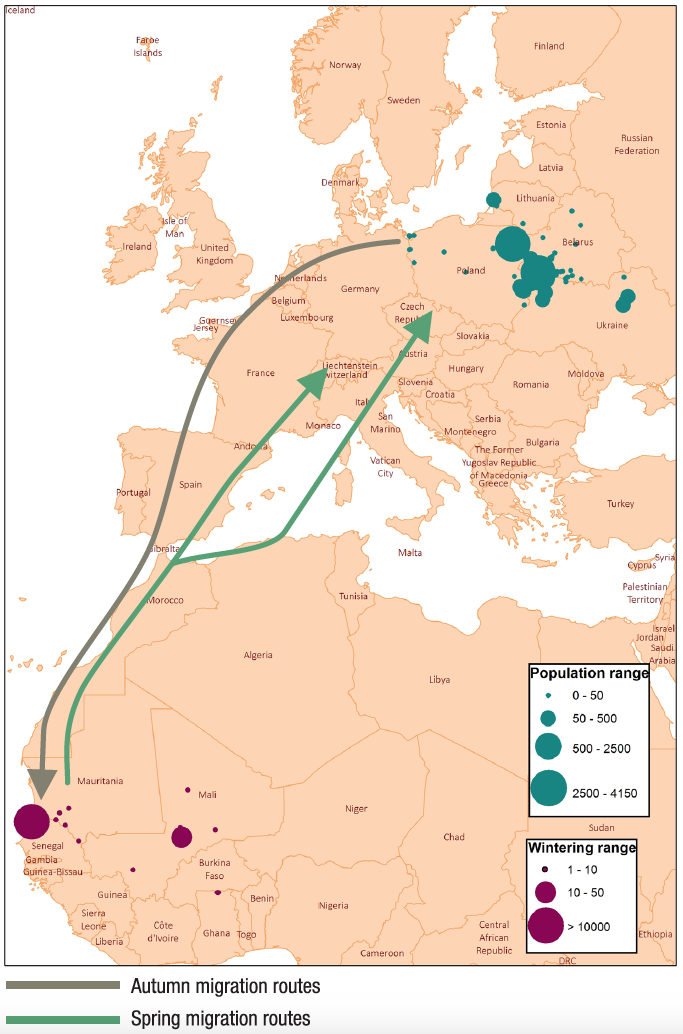
Global breeding area covers 375 km2
Species Conservation
- Listed in the Lithuanian Red Book of Threatened Species
- Listed in the IUCN global endangered species red list as “vulnerable”
- Included as a priority species for the EU in Annex I of the Birds Directive.
- 22 countries signed the Aquatic Warbler Memorandum of Understanding, MOU, under the Bonn Convention.
State of the Population in Different countries
In Lithuania

Lithuania is at the norther border of the Aquatic warbler territory. The population here is relatively small. In recent years an increase in the population was recorded after a decade of constant decrease. Scientists say that population is stabile now. Nevertheless, the size of population still fluctuates. Scientists link this to huge isolation of populations, lack of good.quality habitats and unstable conditions in breeding sites. In 2022, the size of population was 208 singing males and in 2023 – 220, in 2024 – 240. More detailed information in PDF.
Belarus

A significant part of the global population of aquatic warblers breeds in Belarus.
Before the massive drainage of mires in 1960-s, the aquatic warbler was nearly continuously distributed in the central part of its breeding range, in the Paliessian lowland. There were c. 99 big fen mires (each of 1 000 ha and more) covering a total area of more than 900 000 ha. The mires were either adjacent to each other, or were located in a distance of 20-40 km. For that period the number of Aquatic Warblers is estimated at about 450 000 singing males.
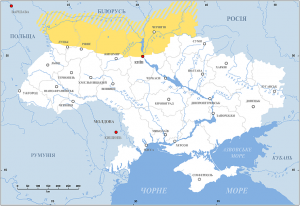
At present there are only 3 key aquatic warbler breeding sites (Zvaniec, Sporava and Dzikoje) left in Paliessie region, holding c. 2 900 – 5 400 singing males (years 2010-2013). The rest of the national population breeds at 5 permanent sites with low numbers (Dzivin, Prostyr, Ščara, Servač and Svislač) resulting in 100 – 200 males and at 7 suboptimal sites holding 50-80 males in total. So, altogether 15 breeding sites were hosting 3 100-5 600 singing males in the years 2010-2013. Most of Belarusian breeding sites located at considerable distance (50-260 km) from each other. Such remoteness lowers the chance of population exchange between sites.
Due to habitat degradation aquatic warbler numbers in Belarus are rapidly declining. At most of the sites, including the key sites Zvaniec and Sporava, the population decline is caused by fragmentation and an overgrowth of open fens with reeds and bushes. Some other sites (Dzikoje, Servač, Aĺmany and Žadzien) are on the way from fens to bogs. In 2017 the population of the country was estimated at 2787-3199 singing males. Later researches show the decease of the population.
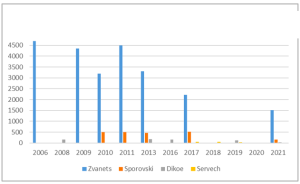
Poland

The Polish breeding population represents almost 25% of the global population. According to the data of 2019, the population size is 4 500 singing males.
Except for the relatively stable large population in the Biebrza valley in north-east Poland little was known about population trends of peripheral populations in western, central and south-eastern regions of the country. A study in 2016 revealed that all small populations of Aquatic Warblers showed a significant decline in total number of individuals and declining number of populations over time. However, population trends were distinctly different in the different regions, with stable dynamics in south-east, moderate decline in north-east and sharp decline in the central and western regions. During the study period (1969–2013) 19 out of 38 populations became extinct (11 populations in the western region, two in central region, four in north-east region and none in the south-east region). Five of these populations were later recolonised thus suggesting a pattern of metapopulation dynamics. To mitigate the negative trends and increased risk of local and regional extinction in the western and central parts of Poland effort should be put to increasing dispersal among populations by increasing the number of stepping stone patches between the viable large eastern populations and the smaller central and western ones.

Ukraine

A significant part of the global population (about 33 %) of aquatic warblers breed in Ukraine. According to the data of 2021, there were 2776-3205 singing males in the country. From 2010 the population is decreasing.
In 2016 a research was conducted to estimate the population of aquatic warblers in Ukraine. The research was done in Desna-Dnipro and Prypiat, which are two main brooding areas of this rare species. The research in Desna-Dnipro sites shows that the estimates of Aquatic Warbler population decreased, due to the fact that the environmental conditions of the habitat this year are worse compared to the conditions observed previously. The number of singing male aquatic warblers there currently range between 153-220.
In the Prypiat brooding area the population of aquatic warblers is also decreasing due to deterioration of key habitats caused by missing spring floods and habitat burnouts. This results in a range of 1857-2095 male aquatic warblers.
Reduced populations of aquatic warblers in both brooding sites resulted in a decreasing trend of total population. Both breeding sites combined comprise the total Aquatic Warbler population of Ukraine which is estimated to range between 2010-2315.
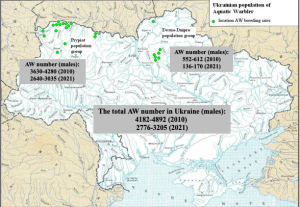
Bellow you can find dynamics of Aquatic Warbler populations in two main habitat groups.
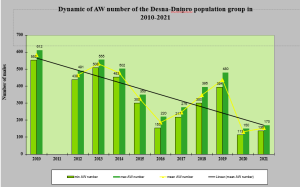
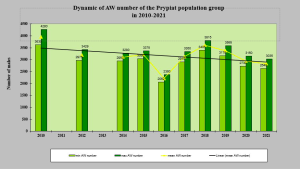
Germany

Even though a few aquatic warblers were noticed in Germany (on the Polish border a few years ago), and the country still has good quality habitats in Pomerania region, no aquatic warbler was found in 2017.
Hungary
Aquatic warblers have not been spotted in Hungary from 2011, when a mysterious extinction happened. Scientists still can not explain this sudden extinction. Rare birds were discovered in Hungary in 1971 in the only site in Hortobágy National Park.
Latvia

In Latvia last breeding season of Aquatic warbler was recorded in 2000-2002. Earlier Latvia was northern border of Aquatic warbler’s breeding area, but because of habitat loss and increasing fragmentation of habitats it was observed that Aquatic warbler do not come to this area for nesting purposes.
Russia

Last breeding season of Aquatic warbler in western Siberia was recorded in 2000. During intense research of Siberian mires in 1999-2001 three very small populations, consisting of 2-3, 1 and 8 singing males, were observed. Now it is thought that these populations might be extinct.


